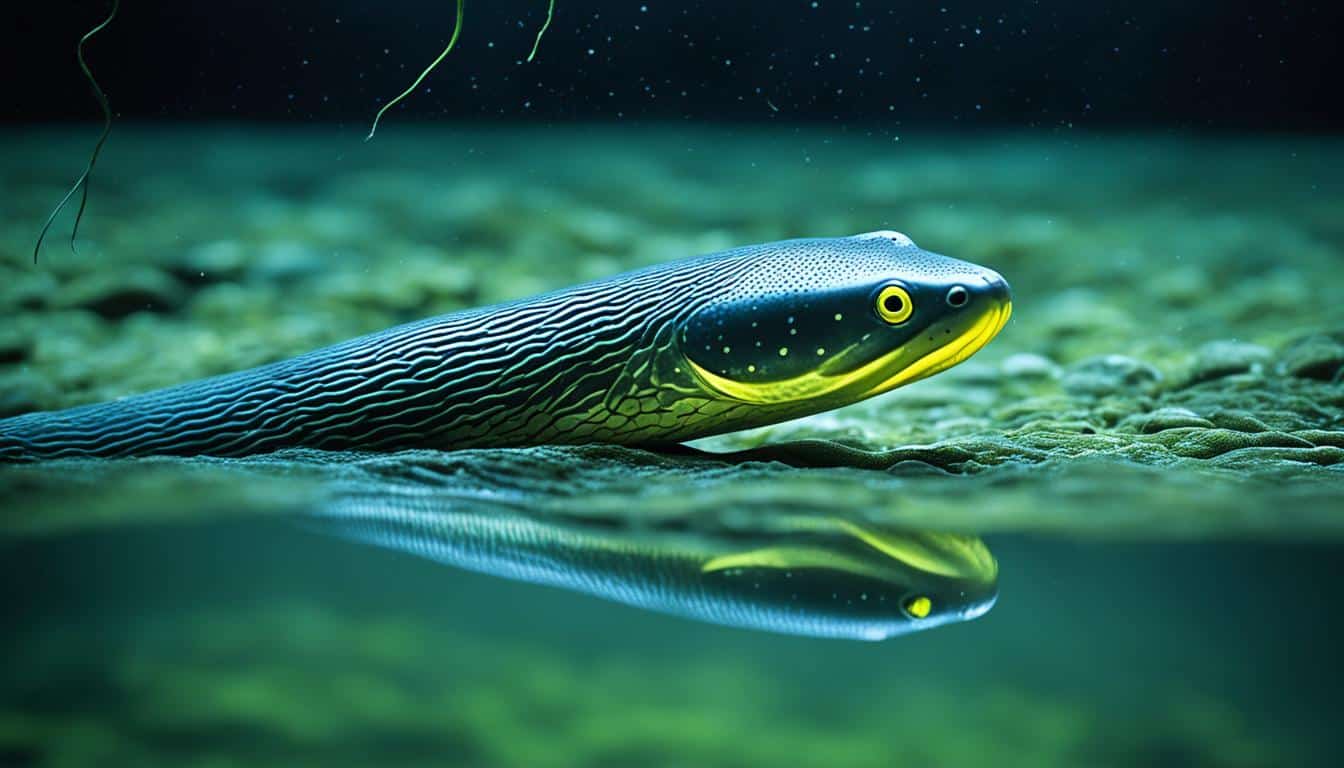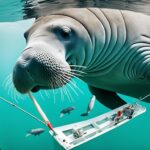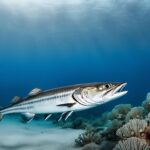Electric eels live in the Amazon Basin and face many threats. It’s important to know these threats to protect these fish and their homes. You’ll learn about the dangers they face, like habitat destruction, climate change, and seasonal changes.
These dangers threaten their natural world. That’s why we need to act to save them.
Introduction to Electric Eels and Their Habitat
Electric eels are fascinating creatures found mainly in northern South America. They live in certain areas that help them survive and adapt. These fish have special features that let them live well in specific places.
Geographical Distribution of Electric Eels
Electric eels live in countries like Brazil, Venezuela, and Colombia. They mostly stay near the Amazon and Orinoco River basins. This lets them live in areas full of different plants and animals.
Preferred Habitats of Electric Eels
Electric eels like slow-moving waters. They live in places like ox-bow lakes, streams, pools, and flooded forests. These spots give them food, shelter, and the right air for breathing.
Adaptations for Life in Slow-Moving Waters
Electric eels have special features for slow-moving waters. They breathe air because they can’t breathe underwater like most fish. Their mouths are designed to take in more air, which is important in low-oxygen areas. These traits help them move and hunt better in their homes.
Environmental Dangers for Electric Eels
Electric eels face many dangers due to changes in their environment. Seasonal changes are a big part of this. They make it hard for electric eels to live.
Seasonal Changes and Water Fluctuation
In wet seasons, electric eels can move into new areas flooded with water. This gives them more food and places to breed. But in dry seasons, the water level drops, trapping them in small pools.
These pools often have less oxygen, making it tough for electric eels to survive. This stress from the seasons adds to the dangers they face.
Impact of Habitat Destruction on Electric Eels
Habitat destruction makes things even harder for electric eels. Deforestation, farming, and building cities destroy their homes. This reduces their living space and affects their food supply.
It also means they have to compete more with other animals. This can lead to fewer electric eels, showing we need to act fast to protect them.
What threats do electric eels face?
Electric eels face threats from both natural predators and human activities. These threats deeply affect their survival and well-being.
Natural Predators of Electric Eels
Large mammals near water bodies are major threats to electric eels. When water levels are low, eels become more vulnerable. This makes it easier for predators to feed on them, impacting local populations.
Human Impacts on Electric Eels and Their Environment
Human actions pose big challenges for electric eels. Pollution from farms, cities, and industries harms their homes. Destroying their habitats through deforestation and changing rivers makes things worse. This makes it harder for electric eels to survive.
Predators and Competition
Electric eels face many challenges to survive. They must deal with threats from predators and competition for resources. These threats affect their well-being in their environment.
Large Mammals as Threats
Capybaras, large mammals, are a big threat to electric eels. They can disrupt the ecosystem and compete for space. When water levels go down, electric eels are more at risk. Their electric defenses might not always protect them from these predators.
Competition for Resources in Shrinking Habitats
Electric eels are fighting for survival as their homes shrink. With less water, there’s less food, making competition fierce. They must find what they need in a small space, making survival harder.

Conservation Concerns for Electric Eels
The well-being of electric eels is linked to many conservation worries. They are listed as “Least Concern” on the IUCN Red List, but their true population status is still a mystery. It’s hard to assess their numbers because they are hard to find and live in complex places.
Current Population Status and IUCN Red List
Recently, conservationists have been keeping an eye on electric eel populations. The IUCN Red List doesn’t fully show the threats they face, like changes to their homes and pollution. These threats could harm their future. We need ongoing research to understand their numbers better and make smart conservation plans.
Protection Efforts for Electric Eel Habitats
To protect electric eel habitats, we’re using several strategies:
- Using sustainable practices to stop destroying their homes.
- Creating laws to keep freshwater clean.
- Projects to fix damaged habitats.
- Working with local people to teach them why electric eels matter.
These efforts aim to help protect electric eels and their homes. This way, we can keep ecosystems healthy for the future.
| Conservation Measures | Description | Expected Outcomes |
|---|---|---|
| Sustainable Practices | Adopting eco-friendly fishing and land use methods. | Minimizes habitat disruption and promotes biodiversity. |
| Pollution Control | Implementing measures to reduce water contaminants. | Improves water quality and the overall health of aquatic ecosystems. |
| Habitat Restoration | Rehabilitating degraded wetlands and riverbanks. | Enhances ecological resilience and supports wildlife. |
| Community Engagement | Educating local populations about electric eel conservation. | Encourages community-based protection efforts and local stewardship. |
The Role of Humans in Electric Eel Endangerment
Humans are a big part of why electric eels are in danger. This is mainly due to pollution and overfishing. Knowing about these threats helps us understand why we need to act to save this special species.
Pollution and Its Effects on Electric Eel Health
Electric eels live in clean water. But, pollution from farms and factories harms their homes. This pollution brings harmful chemicals and too many nutrients into the water.
This hurts their health a lot. Their electroreceptors, which help them find food and navigate, can be damaged by toxins. Also, polluted water can make it hard for them to have babies. Keeping their homes clean is key to their survival.
Overfishing and Its Consequences
Overfishing is a big threat to electric eels. Fishing too much reduces their numbers and upsets the balance in their homes. This loss affects many other species that live there too.
Without enough electric eels, some species might take over, causing more problems. We need to fish in a way that doesn’t harm them. This will help electric eels and the whole ecosystem.
| Human Impact | Description | Consequences for Electric Eels |
|---|---|---|
| Pollution | Agricultural runoff and industrial waste | Diminished health and reproductive capabilities |
| Overfishing | Unsustainable fishing practices | Population decline and ecosystem imbalance |
Research on Electric Eel Behavior and Responses to Threats
Studying electric eel behavior is key to saving them from threats. Research shows they can jump out of water to shock predators with electricity. This skill is vital for their survival in different habitats.
Defensive Mechanisms Against Predators
Electric eels use electric shocks to keep away from big predators in the water. When threatened, they show this behavior to stay on top in their world. Knowing how they defend themselves helps us understand their survival strategies.
Electric Eel Behavior During Dry Seasons
In dry seasons, electric eels change how they act as they’re stuck in smaller water, making them easy targets for land predators. Studies reveal they become more careful and change their hunting ways to fit their new environment. This info is key for saving them as their homes change.
FAQ
What are the main threats to electric eels?
Electric eels face threats like habitat loss from deforestation and farming, pollution from factories, changing water levels, and being eaten by big animals and birds.
How does habitat destruction impact electric eels?
Losing their homes hurts electric eels a lot. It makes their living spaces smaller and less oxygen-rich. This makes it harder for them to survive.
What human activities threaten electric eels?
Humans harm electric eels with pollution from farms and factories, and overfishing. These actions damage their health, ability to have babies, and their homes.
What animals prey on electric eels?
Big animals like capybaras and many birds eat electric eels. They are more at risk when the water level goes down and their homes get smaller.
How are electric eels adapted to their environment?
Electric eels can breathe air and live in low-oxygen water. They have special mouth parts that help them take in more air.
What conservation efforts are in place for electric eels?
People working to save electric eels focus on keeping their homes safe, stopping destruction and pollution, and watching their numbers to help protect them better.
How does pollution affect electric eels?
Pollution makes electric eels’ homes dirty, hurts their ability to have babies, and makes them sick. This makes them more endangered.
What is the current population status of electric eels?
Electric eels are listed as “Least Concern” on the IUCN Red List. But, it’s hard to know how many there are because of the dangers they face.
What unique defense mechanisms do electric eels have?
Electric eels can jump out of the water to shock predators. This is very useful against animals that live on land during the dry season.
How do seasonal changes affect electric eels?
Seasonal changes make the water levels go up and down. This can trap electric eels in small, low-oxygen areas. This makes it hard for them to survive and find food.







